Dene-tha (Slavey)

The Dene-tha people were the most northerly tribe in what is now known as Alberta. The Dene-tha people were closely related to the Dunne-za. When the Dunne-za people were first contacted by Europeans they occupied the territories west of what is now known as Lake Athabasca. With the arrival of the Cree they were pushed to the territories west of Great Slave Lake. Dunne-tha still claims northern Alberta as a part of their traditional territories.
The Dene-tha were known as hunters of deer and woodland caribou. The Dene-tha were also more dependent on fish than the Dunne-za.
Dene-tha were known for their decorative clothing and continue to have some of the best bead work of Aboriginal people.
The first direct trading with Europeans occurred in 1778, when French traders arrived in the area. The remoteness of the Dene-tha from trading posts kept fur trading activities to a minimum until the 1860s.

The Dene-tha did not attend the negotiations for Treaty 8 in 1899. Some bands signed the Treaty 8 in 1900, while another group signed in 1902.
The Dene-tha, like the Dunne-za, suffered a significant depletion of their population from diseases introduced by Europeans. The Dene-tha had a population of only 800 until improved healthcare was available after the Second World War. The improvements in health allowed the population of the Dene-tha to increase to 4,081 by 1983.
The Dene-tha work in the oil industry and forestry around High Level, Zama City, and Rainbow Lake.




